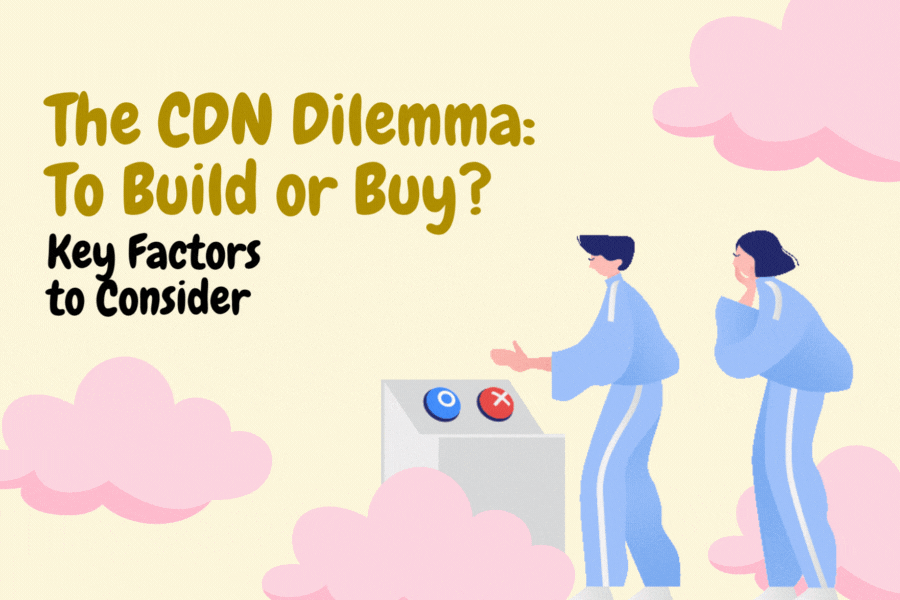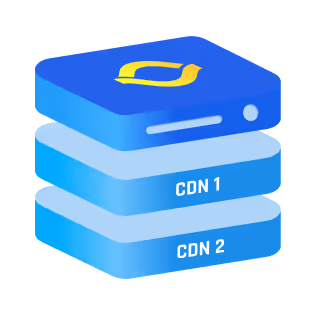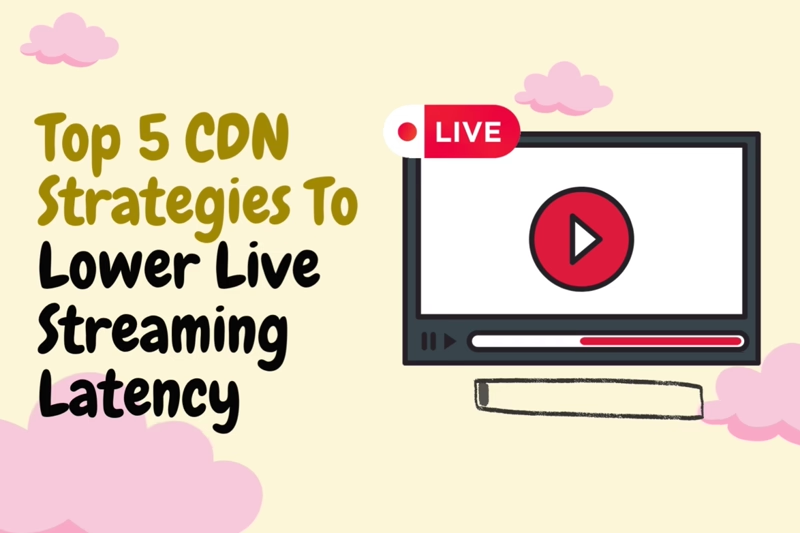The CDN Dilemma: To Build or Buy? Key Factors to Consider
Should you build or buy a CDN? Learn the key factors, cost, control, scale, to make the right choice for performance and growth.

You want your site or app to feel instant, no matter where your visitors live. That means placing copies of your content close to them through a content delivery network, or CDN system. Now you face a choice.
Do you spend time and money to build a private network, or do you buy CDN capacity from a provider that already owns a global network infrastructure? Let’s walk through that decision, step by step.
How a CDN Works in Simplest Terms
A CDN keeps extra copies of images, style sheets, videos, and even dynamic API responses on servers spread around the world. When someone clicks your page, the closest server answers. Less distance equals faster load times. Key CDN features you will lean on include:
- Edge caching: Stores popular files so the origin server rests.
- Smart routing: Sends each visitor to the fastest path in real time.
- TLS off-load: Handles encryption work at the edge, which means fewer CPU cycles on your side.
- Built-in security: Filters attacks before they touch your own stack.
These basics deliver the core CDN benefits: lower latency, better uptime, fewer origin costs, and built-in shielding from denial-of-service floods.
{{promo}}
What Building a CDN Really Takes
Building sounds tempting. You keep full control and avoid provider markups over the long haul. But the real bill is larger than many teams expect.
- Capital: Racks, routers, and storage spread across continents cost millions up front.
- People: Around-the-clock operations need network engineers, site-reliability staff, and security responders. Salaries soon exceed hardware spend.
- Power and space: Colocation fees recur every month whether traffic grows or not.
- Peering hurdles: Carriers will not trade traffic for free until you reach huge scale. Until then you buy pricey transit, which erases savings.
- Time: Expect years before the first edge site meets your performance goals in every region. During that time competitors may outrun you.
Unless content delivery is your core product and you already push petabytes per month, building rarely ends up cheaper.
The Upside of Buying a CDN
When you buy CDN services, you plug into a mature platform on day one. Key advantages follow.
- Instant reach: You get hundreds of edge sites, deep carrier peering, and Anycast routing without lifting a wrench.
- Elastic cost model: Pay only for bytes served and requests made. No stranded capacity.
- Rapid feature adoption: Need HTTP 3? Image compression on the fly? Edge compute? Providers roll out new CDN features without work on your end.
- Strong security posture: Enterprise-grade DDoS defense and web-application firewalls come baked in, managed by teams that fight attacks full time.
- Focus on product: Your engineers spend time shipping user-facing value instead of tuning BGP routes.
The direct expense per gigabyte may look higher than self-hosting, yet the hidden savings in labor, speed to market, and avoided downtime often make the ledger swing your way.
Decision Drivers You Cannot Ignore
Every build-versus-buy argument boils down to five big levers. Walk through them in this order, and the right choice usually reveals itself before the last step.
1. Traffic Shape and Certainty
First, map your bandwidth curve. If usage jumps with product launches, sales events, or viral spikes, a pay-as-you-go buy CDN keeps you safe; elastic cost, instant headroom, no frantic hardware orders.
A build only makes sense once traffic is not just high but predictably high month after month. Otherwise, you end up funding empty racks during the quiet weeks.
2. Audience Geography vs. Existing Footprint
Next, overlay your user hotspots on a world map. Ask a simple question: “Does a provider already serve my core cities with low-latency points of presence?” If yes, you gain global reach in hours by buying.
If no, and your brand hinges on sub-50-ms page loads in an underserved region; building (or at least colocating a few private edge nodes) might be worth the hassle just to own that last-mile speed.
3. Talent and Culture Reality Check
Operating a global network is not a side quest. You need BGP veterans, SREs, and 24 × 7 security staff who treat packet loss like a house fire.
If that headcount feels out of reach, or would pull your best people off product work; stick to vendor capacity. Freeing minds to ship features nearly always beats chasing router firmware bugs at 3 a.m.
4. Total Cost of Ownership, Not Sticker Price
Now run the numbers with brutal honesty. Blend hardware refresh cycles, colocation rent, premium IP transit, support rotations, and the cost of a single multi-hour outage.
Stack that five-year sum against provider invoices (plus cloud egress on cache misses). For all but petabyte-scale media giants, the buy column stays lower well past the planning horizon.
5. Depth of Control You Actually Need
Finally, pin down what “control” means for you. If all you crave is smart cache rules, token auth, and serverless edge functions, today’s commercial platforms deliver more knobs than most teams ever twist.
Building only wins when you must rewrite network protocols, ship custom hardware, or embed delivery as a defensible product advantage; as Netflix did with Open Connect.
{{promo}}
Build vs Buy: Comparison Snapshot
Here’s a holistic view of both decisions:
Fixed vs Variable Spend in CDNs
If you think “I’ll build because it must be cheaper in the long run,” pause a second. Cost inside a private CDN system is never a clean per-gigabyte line item:
- Capacity you can’t throttle: You reserve racks, power, and transit months in advance. When traffic dips, those bills keep ticking. A buy CDN deal, by contrast, flexes with real demand.
- Baseline upkeep: Even idle servers burn power, need patching, and force hardware refresh cycles every three to five years. A provider spreads that load across thousands of customers inside its global network infrastructure.
- Insurance against spikes: You still have to overbuild for peak holiday or launch traffic. If the surge never shows, you’ve paid for empty lanes. Commercial or “virtual” CDNs let you rent those lanes only when the rush arrives.
- Opportunity cost: Every dollar locked in metal is a dollar not driving new features or marketing. Buying network capacity frees capital for growth plays the finance team actually cares about.
If raw cost is your lone driver, buying or even layering a virtual, multi-tenant CDN often beats rolling your own iron; because you stop paying for traffic you never send and start reaping all the normal CDN benefits without fixed overhead.
A Quick Reality Check
Ask yourself five direct questions.
- Is content delivery my main business edge, or just a utility?
- Can I afford a multi-year global rollout before I see return?
- Do I have the budget and appetite to hire at least a dozen seasoned network and security engineers?
- Will a half-second faster page really move my revenue needle enough to justify that spend?
- Could a hybrid path, mixing multiple vendors with small private caches, give me ninety-nine percent of the gain at a fraction of the pain?
If most answers point toward vendor help, buying network capacity is the rational move.
Conclusion
Unless you operate at the scale of the largest video platforms, a commercial CDN unlocks global speed, enterprise security, and room to grow, all while freeing your team to ship features your customers actually touch.
Building a CDN should always be the final straw, it’s almost never worth it. If a single CDN can’t fit your use case, just use a multi CDN setup.
FAQs
1. Is building my own CDN always cheaper than a buy CDN plan?
Not really. You pre-pay for racks, power, and transit whether traffic shows or not. A buy CDN lets you match spend to real demand, avoids surprise hardware swaps, and spreads upkeep across a global network infrastructure shared by many customers.
2. What happens if my traffic spikes without warning?
With a private CDN system, you overbuild “just in case,” so unused capacity sits idle. Commercial or virtual CDNs auto-scale in seconds, giving you elastic headroom only when you need it; no panicked hardware orders, no blown budgets.
3. Do I lose control of performance when I outsource?
You still control key CDN features: cache rules, edge compute functions, token auth, and near-instant purging. The provider handles the plumbing; anycast routing, peering, and DDoS scrubbing; while you focus on tuning the bits your users actually feel.
4. Can I start small and still add my own PoPs later?
Yes. Many teams buy CDN capacity first, then layer private nodes in one or two regions as traffic grows. A multi-CDN manager can route users between your PoPs and the vendor’s edge to blend control with global reach.
5. How hard is it to switch providers if I outgrow the current one?
Most modern buy CDN contracts support short ramp-down periods. Use provider-agnostic CNAMEs, mirrored cache rules, and scripted purging so you can migrate in weeks, not months. A staged multi-CDN setup keeps downtime near zero while you cut over.



.png)
.png)
.png)





